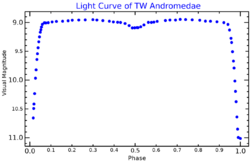Astronomy:TW Andromedae
| Observation data Equinox J2000.0]] (ICRS) | |
|---|---|
| Constellation | Andromeda |
| Right ascension | 00h 03m 18.22724s[2] |
| Declination | +32° 50′ 45.10209″[2] |
| Apparent magnitude (V) | 8.98 – 11.050 variable [3] |
| Characteristics | |
| Spectral type | F0V + K0 [3] |
| B−V color index | 0.11[4] |
| Variable type | EA[3] |
| Astrometry | |
| Radial velocity (Rv) | −51.27±0.42[5] km/s |
| Proper motion (μ) | RA: 52.569 ± 0.053 [2] mas/yr Dec.: -2.770 ± 0.028 [2] mas/yr |
| Parallax (π) | 3.1877 ± 0.0442[2] mas |
| Distance | 1,020 ± 10 ly (314 ± 4 pc) |
| Orbit | |
| Period (P) | 4.12 [6] days |
| Semi-major axis (a) | 13.6 R☉ [6] |
| Eccentricity (e) | 0.0 [7] |
| Inclination (i) | 86.9 [6]° |
| Periastron epoch (T) | JD 2440700±300[7] |
| Semi-amplitude (K1) (primary) | 27±1.5[7] km/s |
| Semi-amplitude (K2) (secondary) | 140±2.0[7] km/s |
| Details | |
| TW And A | |
| Mass | 1.685[8] M☉ |
| Radius | 2.05[6] R☉ |
| Luminosity | 4.3[8] L☉ |
| Temperature | 7250±25[8] K |
| TW And B | |
| Mass | 0.325[8] M☉ |
| Radius | 3.20[6] R☉ |
| Luminosity | 14.5[8] L☉ |
| Temperature | 4658[8] K |
| Other designations | |
| Database references | |
| SIMBAD | data |
TW Andromedae (TW And) is an eclipsing binary star, classified also as an Algol variable star, in the constellation Andromeda. Its brightness varies with a period of 4.12 days, and has a typical brightness of magnitude 8.98 but decreasing down to a magnitude of 11.04 during the main eclipse.[3]
TW Andromedae was discovered to be an Algol variable by August Kopff in 1909.[9]
The TW Andromedae system is made of two stars in a circular orbit around their center of mass, with an orbital plane almost parallel to our line of sight. The presence of a third body in the system, with a minimum mass of 0.27 M☉ and an orbital period of 49.6 years, has been proposed to account for the observed changes in the period of the variability.[7]
Like in all Algol variable stars, when both stars of the system are aligned with respect to our line of sight, the furthest component blocks the light of the other, thus the apparent luminosity of the system diminishes. When the brightest component eclipses the other, a secondary, less pronounced minimum in the luminosity occurs.
References
- ↑ Ammann, M.; Walter, K. (April 1973). "Photoelectric light curve of the Algol system TW Andromedae and the interpretation of its distortions by the effects of hot spots". Astronomy and Astrophysics 24: 131. Bibcode: 1973A&A....24..131A. https://ui.adsabs.harvard.edu/abs/1973A%26A....24..131A/abstract. Retrieved 6 October 2021.
- ↑ 2.0 2.1 2.2 2.3 2.4 Brown, A. G. A. (August 2018). "Gaia Data Release 2: Summary of the contents and survey properties". Astronomy & Astrophysics 616: A1. doi:10.1051/0004-6361/201833051. Bibcode: 2018A&A...616A...1G.
- ↑ 3.0 3.1 3.2 3.3 TW And, database entry, Combined General Catalog of Variable Stars (GCVS4.2, 2004 Ed.), N. N. Samus, O. V. Durlevich, et al., CDS ID II/250 Accessed on line 2009-06-30.
- ↑ Høg, E.; Fabricius, C.; Makarov, V. V.; Urban, S.; Corbin, T.; Wycoff, G.; Bastian, U.; Schwekendiek, P. et al. (2000), "The Tycho-2 catalogue of the 2.5 million brightest stars", Astronomy & Astrophysics 355: L27–L30, Bibcode: 2000A&A...355L..27H.
- ↑ de Bruijne, J. H. J.; Eilers, A.-C. (October 2012), "Radial velocities for the HIPPARCOS-Gaia Hundred-Thousand-Proper-Motion project", Astronomy & Astrophysics 546: 14, doi:10.1051/0004-6361/201219219, A61, Bibcode: 2012A&A...546A..61D.
- ↑ 6.0 6.1 6.2 6.3 6.4 Rattenbury, N. J. (January 2009), "Microlensing of close binary stars", Monthly Notices of the Royal Astronomical Society 392 (1): 439–447, doi:10.1111/j.1365-2966.2008.14074.x, Bibcode: 2009MNRAS.392..439R.
- ↑ 7.0 7.1 7.2 7.3 7.4 Kreiner, J. M.; Pribulla, T.; Tremko, J.; Stachowski, G. S.; Zakrzewski, B. (2008), "Period analysis of three close binary systems: TW And, TT Her and W UMi", Monthly Notices of the Royal Astronomical Society 383 (4): 1506–1512, doi:10.1111/j.1365-2966.2007.12652.x, Bibcode: 2008MNRAS.383.1506K.
- ↑ 8.0 8.1 8.2 8.3 8.4 8.5 Malkov, Oleg Yu (February 2020). "Semidetached double-lined eclipsing binaries: Stellar parameters and rare classes". Monthly Notices of the Royal Astronomical Society 491 (4): 5489–5497. doi:10.1093/mnras/stz3363. Bibcode: 2020MNRAS.491.5489M.
- ↑ Kopff, August (December 1909). "Beobachtungen des Algolvariablen 21.1909 Andromedae (BD +32°4756)". Astronomische Nachrichten 183 (7): 109. doi:10.1002/asna.19091830704. Bibcode: 1909AN....183..109K. https://onlinelibrary.wiley.com/doi/pdf/10.1002/asna.19091830704. Retrieved 24 February 2023.
 |


